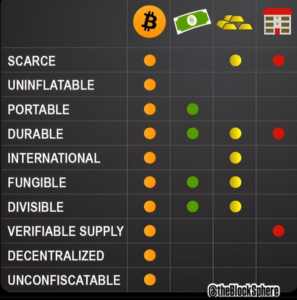The Qualities of Sound Money
What makes money money? It’s not just paper or coins jingling in your pocket—it’s a tool we trust to hold value, trade easily, and stick around. History’s got a checklist for this, and it’s not rocket science: money needs to be durable (won’t rot or break), portable (easy to carry), divisible (can split into small chunks), fungible (one unit’s the same as another), and scarce (can’t be infinite). Think about seashells or beads tribes once used—they worked until someone found a beach full of them. Bitcoin nails this test like a champ. It’s digital, so it doesn’t wear out (durable); you can send it across the world from your phone (portable); you can break it into tiny “satoshis” for a coffee or a car (divisible); every Bitcoin’s identical (fungible); and with just 21 million ever, it’s scarce as hell. For regular folks, this means money that fits our lives—modern, flexible, and tough.

Now stack that up against fiat—the dollars or euros we’re stuck with—and it’s a different story. Paper money’s got some tricks: it’s durable enough (until it rips), portable in your wallet, divisible into pennies, and fungible (a buck’s a buck). But here’s where it flops: scarcity. Governments can print it like confetti—trillions during a crisis, billions on a slow day—and every new stack shrinks what’s in your bank account. Remember post-2020, when prices for everything from eggs to rent shot up? That’s fiat failing the scarcity test, leaving us with cash that buys less every year. Bitcoin’s cap is its ace: no one can flood the system, so your slice of the pie doesn’t get watered down. It’s like owning a rare comic book while fiat’s a newspaper they keep reprinting—guess which one’s worth more over time?
Let’s rewind for some perspective: gold used to be king. For centuries, it checked the boxes—durable (doesn’t rust), portable (in coins or bars), divisible (melt it down), fungible (gold’s gold), and scarce (you don’t dig up mountains of it daily). People hoarded it, fought wars over it, built empires on it. But gold’s got baggage: lugging it around’s a hassle, and you can’t email it to your cousin in Texas. Bitcoin’s the “digital gold” upgrade—same scarcity vibe, but built for today. It’s weightless, zipping through the internet, and secured by code tougher than Fort Knox. Your wealth doesn’t need a vault or a mule train; it’s in your pocket, ready when you are.
Why does this matter to you? Because the money we use shapes our lives. Fiat’s lack of scarcity is why a house that cost $50,000 in 1970 now takes $500,000—your dollars can’t keep up. Bitcoin’s design says, “Hold on, let’s reverse that.” Imagine needing less Bitcoin for that house in 20 years, not more, because its value climbs while fiat sinks. That’s not a fantasy; it’s what scarcity does. Gold showed us the blueprint—rare stuff holds worth—but Bitcoin takes it to the streets, for anyone with a smartphone. Fiat’s letting us down and Bitcoin’s picking up the slack, one quality at a time.
“Sound money” isn’t just jargon—it’s the difference between a system that screws you and one that saves you. Bitcoin checks the boxes fiat can’t, offering a lifeline to everyday people tired of watching their cash lose its punch. It’s not about nostalgia for gold bars; it’s about a future where your money’s as solid as you need it to be—durable, portable, divisible, fungible, and scarce. Bitcoin’s not just better tech—it’s better money, built for a world that’s done with fiat’s flimsy promises.
